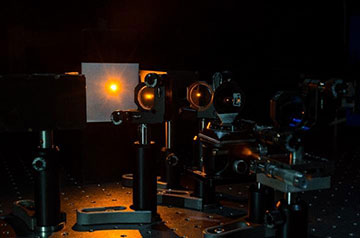
Researchers used a two-step nonlinear frequency conversion to convert mid-infrared laser light into yellow light that can be tuned from 570 nm to 596 nm. [Image: Varun Sharma]
A practical yellow laser could bring significant innovation to the fields of biomedical optics, spectroscopy and astronomy. Obtaining yellow laser light, however, requires bulky, inefficient equipment like organic dye or copper vapor lasers.
Now, a research team in India, using off-the-shelf technology—and just the right crystals—reports extraction of ultrafast yellow radiation in the 570-to-596-nm range and with excellent beam quality from a CR2+:ZnS laser (Optics Lett., doi: 10.1364/OL.404358).
Painstaking crystal selection
In their experimental setup, says co-author Anirban Ghosh of the Photonic Sciences Lab at India’s Physical Research Laboratory (PRL) in Ahmedabad, the researchers used a system of wave plates, dichroic mirrors and painstakingly selected nonlinear crystals to guide the laser light through a two-stage frequency-doubling process.
“The advantage of this setup is the simplicity,” Ghosh says, but selection of the crystals was key. Finding the appropriate nonlinear crystal for the efficient frequency conversion took a little bit of time at first, he admits. “But once you have the right crystals—in this case, MgO:PPLN [periodically poled MgO-doped lithium niobate] and bismuth triborate crystals—the laser can be developed within a day.”
With their setup, the researchers say, they were able to produce tunable, yellow radiation in the 570-to-596-nm range at an output power of 1 W with 130 femtosecond pulses repeating at 80 MHz.
The promise of yellow light
Potential applications for tunable femtosecond yellow lasers are promising, Ghosh says. In medicine, for example, the laser is well matched to the spectral absorbance of hemoglobin. Combined with the laser’s power and small pulse duration, the light should cause less thermal damage and thus provide more selective and less traumatic treatment for conditions like macular photocoagulation, port-wine stain (birthmark) removal, eye surgery and more.
Because of the spectral sensitivity of the cone opsins in the human retina, he continues, a femtosecond yellow laser could give rise to consumer products such as full-color video projection.
In their paper, the PRL researchers note that a pulsed yellow laser emitting at the sodium absorption line of 589 nm can be used to create a laser guide star for Earth-based astronomy telescopes. This could eliminate the need for bulky, power-hungry laser systems to create guide stars, Ghosh says.
Though the team has not explored commercialization of their yellow laser system, says Ghosh, “we are open for future collaboration with people working in medicine.”
Selective-wavelength lasers
In recent years, Ghosh says, researchers have tried a variety of nonlinear frequency-conversion techniques to generate yellow radiation from near-IR sources: optical parametric oscillators, cavity-enhanced sum frequency generation, frequency doubling of Raman shifted fiber laser-based systems or of diode-pumped Yb-doped fiber lasers, and frequency doubling of vertical external-cavity surface-emitting diode lasers.
“While these sources have been used successfully for various applications,” Ghosh says, “they suffer from one or more drawbacks in terms of low average power, lack of good spatial beam profile, limited or no wavelength tunability, and broad output pulses.”
Sixty years after the first demonstration of the laser, Ghosh adds, “we have just a handful of commercially available lasers with selective wavelength coverage across the electromagnetic spectrum because of the unavailability of suitable laser gain medium.”
Exploring alternative crystals
Now, having possibly found a way around that problem, Ghosh says, the next step for the PRL team’s research is to improve its yellow laser’s parameters in terms of pulse duration, efficiency and compactness.
“To improve the efficiency, we are exploring alternative nonlinear crystals such as periodically poled MgO-doped lithium tantalate or periodically poled potassium titanyl phosphate, having large nonlinear gain in comparison to the bismuth triborate crystal used in the current experiment,” Ghosh says. “It is also important to optimize the grating period of the periodically poled crystals for room temperature operation.”
Practical application of the entire laser system, Ghosh says, will also require optimization and verification of its reliability for long-term operation without any active administration.
